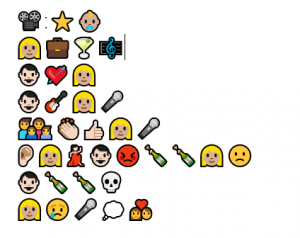
– Did you choose the work based on how easy it would be to visualize?
Yes, I have chosen a different work from my initial thought because of two main difficulties. And I have found that selecting a suitable work vastly reduced the time to recreate the plot.
The first difficulty is the missing consensus. My initial idea was for a movie aired in China only. It would be difficult to represent its plot using emojis because very few people would be able to guess the movie, regardless of how accurate and precise the representation is. In the process of changing my mind, I realized that although emojis and pictures are both visual representations, emojis have more commonalities with words such that texts constructed by emojis are inevitably vague. We can extend Kress’s (2005) argument from words to emojis; when representing semantics with emojis, the meanings are ill-fitted into the limited amount of symbols, and interpretation based on conventions is necessary for understanding these signifiers. The cultural and social context must be considered to avoid misunderstanding or being offensive. For example, the open palm ✋ means high-five in western countries, but it is a curse in Pakistan (Ormerod, n.d.). In addition, “new rules” may assign hidden meanings or alter the original meanings (Zaltzman, 2019) of emojis, and such changes can in turn influence human perceptions. For example, the banana or eggplant emojis can represent more than the fruit and the vegetable in some contexts. The characteristics of the emoji language contribute to the difficulty of recreating the movie plot to a diverse audience group with different prior knowledge.
Another difficulty is that emoji lacks the essential signifiers to represent the plot. In this activity, no words are allowed. However, in real life, words and emojis have not yet replaced each other; they co-exist with a constantly shifting hegemony (Bolter, 2001) and they are usually used together to convey the complete idea. For example, “good work” with an eye-rolling emoji represent sarcastic feelings, and the emoji in this case takes the primary role. On the other hand, “good work” with a smiley face emoji represents praise, and the words take the primary role to communicate the praise. It is argued that representing the plot of my initial idea, “conducting a rescue mission that saved millions of lives”, is very difficult with just graphical icons.
– Did you rely more on syllables, words, ideas, or a combination of all of them?
I relied on the combination of words, ideas, and visual recreation. The title of the movie only consists of descriptive words, so it is easier to “directly translate” the words into emojis. On the other hand, the plot contains emotions, social interactions, and complex activities, so it is more easily redesigned based on ideas. Note that both the primary “picture writing” (Bolter, 2001, pg. 59) technique and the effect of literary culture are manifested in the emoji representation. The visuals in the movie directly affected my choices of emojis, thus “showing the world” (Kress, 2005) to some extent. In addition, the emojis also “tell the word” (Kress, 2005) by constructing an ordered narrative following the conventions of English writing: from left to right, from top to bottom, moving to a new paragraph to express logical separation.
References
Bolter, J. D. (2001). Writing space: Computers, hypertext, and the remediation of print (2nd ed.). Mahwah, N.J: Lawrence Erlbaum Associates.
Kress. (2005). Gains and losses: New forms of texts, knowledge, and learning. Computers and Composition, Vol. 2(1), 5-22.
Ormerod, A.G. (n.d.). Caution! These emoji mean different things in different countries. Rest of world. https://restofworld.org/2021/list-emoji-different-meanings/
Zaltzman, H. (Host). (2019). New Rules. [Audio podcast episode]. In Allusionist. Omny Studio. https://www.theallusionist.org/new-rules